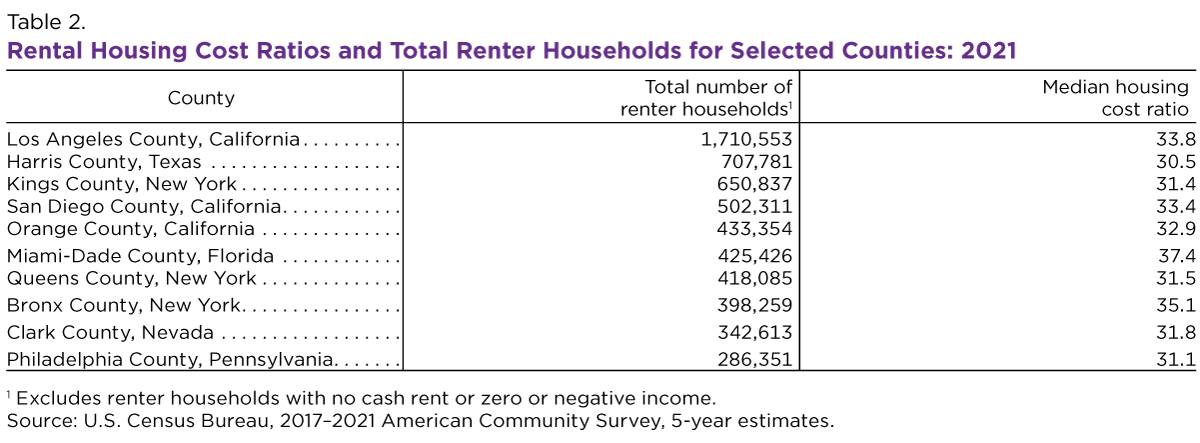Renters More Likely Than Homeowners to Spend More Than 30% of Income on Housing in Almost All Counties
Over 19 million U.S. renter households spent more than 30% of their income on housing costs in 2021, according to data from the 2017-2021 American Community Survey (ACS) 5-year estimates released today.
Households are considered cost burdened when they spend more than 30% of their income on rent, mortgage and other housing needs.
The burden was especially high in some of the nation’s largest counties where housing is more expensive or in areas where incomes are low.
The ACS collects a variety of housing cost information for renters (monthly rent and utility bills) and for homeowners (mortgage principal and interest, real estate taxes, homeowner’s insurance, utilities, mobile home costs, second mortgage payments and condominium fees if applicable).
Nearly half of the counties where renters had the highest median housing cost ratios were in the South.
Out of the 44 million renter households, the vast majority (41 million) paid rent and had household income. Households with zero or negative income, or those in rented units not paying cash rent, were excluded from calculations.
In 239 or 7.6% of the nation’s 3,143 counties, more than half of renter households that paid rent and had a household income faced housing cost burdens.
Among them are some of the most populous U.S. counties like Harris County, Texas, and Los Angeles County, California. Over 15.8 million renters, roughly one-third of all renter households in the nation, lived in these 239 counties.
In contrast to the prevalence of burden faced by renters, the median housing cost ratio for homeowners rarely topped 30%, and homeowners with and without a mortgage frequently had lower overall housing costs than renters.
Homeowners in only 18 counties – less than half a percent of all counties – had a higher housing cost ratio than renters. In fact, there were only two counties where the median housing cost ratio for homeowners (with a mortgage) was above 30%: Taliaferro County, Georgia, and Trinity County, California.
High Housing Cost Burden Most Common in South, Large Metros
Nearly half of the counties where renters had the highest median housing cost ratios were in the South. Florida, Louisiana, Texas, and Mississippi were among the states with the largest number of counties where renters’ median housing costs exceeded 30% of their income.
But among states with more than 10 counties where the median cost ratio was a burden, New Jersey has the highest proportion of counties with cost burdened renter households.
Table 2 shows the 10 U.S. counties with median housing cost ratios above 30% and the largest number of renter households.
This list includes 8 of the 12 largest counties by total household population, an indication that that renter housing cost burdens were highest in many of the country’s most populous areas.
In these counties, more than half of renter households that paid rent and have household income spend more than 30% of their income on housing costs.
But areas where renters were cost burdened the most were not always the same areas where homeowners faced the highest costs.
For example, there were no counties where the median cost ratio exceeded 30% for homeowners who owned their home free and clear and did not have a mortgage. The difference between renters and homeowners was clear in counties where renters had high housing cost ratios.
Homeowners in most of the country had a lower median cost burden than renters.
High housing costs can impact the amount of money households are able to save or use for other essential and nonessential expenses. The most recent ACS data show that renters were particularly vulnerable to cost burdens.
Future ACS releases, both the one- and five-year, will be critical to understanding how many households in the country continue to be burdened by housing expenses.
Related Statistics
Subscribe
Our email newsletter is sent out on the day we publish a story. Get an alert directly in your inbox to read, share and blog about our newest stories.
Contact our Public Information Office for media inquiries or interviews.
-
America Counts StoryHousing Vacancy Rates Near Historic LowsMay 12, 2022Housing Vacancy Survey shows that availability of homeowner and rental housing tightened during the COVID-19 pandemic.
-
America Counts StoryHousing Growth Highest in Urban Cores of Fast-Growing MetrosNovember 02, 2021The 2020 Census shows the nation’s housing stock increased from 2010 to 2020 but growth was uneven across the country.
-
America Counts StoryZillow and Census Bureau Data Show Pandemic’s Impact on Housing MarketOctober 04, 2021The housing market stalled in spring 2020 but rebounded by summer.
-
NAICS Sector 31-33 ManufacturingSome Less Populous States Have High Manufacturing Revenue Per CapitaSeptember 29, 2025Today is the start of a week of celebrations at the Census Bureau marking the 14th annual Manufacturing Day on October 3.
-
Families and Living ArrangementsCouples’ Finances: Married but SeparateSeptember 24, 2025While most married couples had joint bank accounts, fewer shared all their financial accounts.
-
FertilityChildlessness on the Rise — Except for Women Ages 45 to 50September 23, 2025From 2014 to 2024, the share of older mothers rose as fewer teens and women in their 20s and 30s had children.
-
Business and EconomyHow AI and Other Technology Impacted Businesses and WorkersSeptember 17, 2025Businesses report that, in most cases, adoption of new technologies like robotics and Artificial Intelligence had no impact on worker numbers or skill level.







